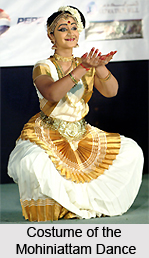 Mohiniattam or Mohiniyattam is an Indian classical dance form that evolved in the state of Kerala, India, and is counted among the two popular dance arts of the state, the other being Kathakali. Although its roots date back to the age-old Sanskrit Hindu text on performing arts called "Natya Shastra", similar to other Indian classical dance forms, Mohiniattam adheres to the Lasya type that showcases a more graceful, gentle and feminine form of dancing. The costume is usually consisted of a choli and a white, or off-white Kasavu saree of Kerala with a gold or red border.
Mohiniattam or Mohiniyattam is an Indian classical dance form that evolved in the state of Kerala, India, and is counted among the two popular dance arts of the state, the other being Kathakali. Although its roots date back to the age-old Sanskrit Hindu text on performing arts called "Natya Shastra", similar to other Indian classical dance forms, Mohiniattam adheres to the Lasya type that showcases a more graceful, gentle and feminine form of dancing. The costume is usually consisted of a choli and a white, or off-white Kasavu saree of Kerala with a gold or red border.
Dresses of Mohiniattam Dancers
One of the distinctive features of the Mohiniattam is the simplicity of the costumes. There is a typical costume for Mohiniattam, which is a mixture of white and gold. They usually consist of a choli and a white, cream or off-white colored sari with a gold or red-bordered Kasavu saree of Kerala worn in such a manner that a pleated fan is formed like an apron in front of the waist. White is a favourite colour of the people basically because of the hot and humid climate. Mohiniattam maintains realistic make-up and simple dressing which is very much a characteristic of women from Kerala.
Ornaments of Mohiniattam Dancers
The beauty of Indian classical dance also lies in its appropriate and relevant costume and jewelry. The dancer usually wears gold ornaments, which symbolizes purity, truth and immortality - all these are attributed to the dance of the celestial maidens. Gold jewellery including necklaces, bangles, waistbands and anklets adorn the body of the dancer and their tinkling makes music as she dances. The dancer also wears a pair of large round ear studs known as Toda, which is circular like a coin and has dangling earrings which is known as "jhumka". The necklace choker is the traditional Nagapadam in the shape of a snake"s hood, and the powanmala - a chain made of gold coins or kasimala. The forehead is covered with an ornament called the Nethichutti and the nose is adorned by Mukkuthi or nose ring. The bangles are known as Kappu. Musical anklets called ghunghru made of leather straps with small metallic bells attached to it are wrapped around the ankles. These produce rhythmic sound while the dancer showcases excellent footwork.
Makeup and Hairstyle of Mohiniattam Dancers
The dancer"s hair is gathered in a bun that is worn at the side of the head and decorated with jasmine flowers and with a simple ornament tied on the bun. The face is done up with an exaggerated eye make up to help her express her emotions. The eyes reflect immediately the mental state of the situation or character the dancer is representing and a description of Mohiniattam cannot be complete without the mention of the nayan abhinaya or the use of the eyes, eyebrows and eyelids. The tilaka or the red mark on the forehead represents matrimony faithfulness of the Hindu women.



















